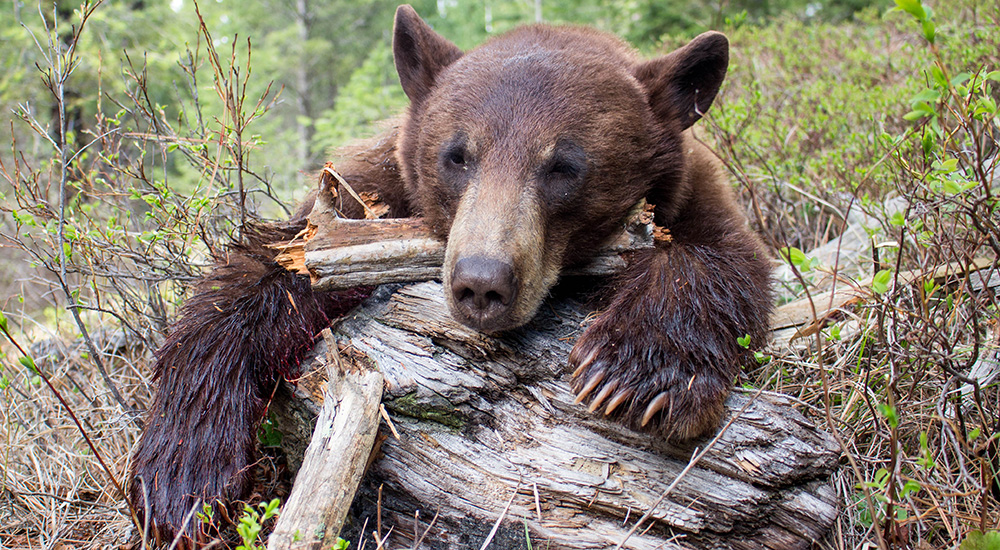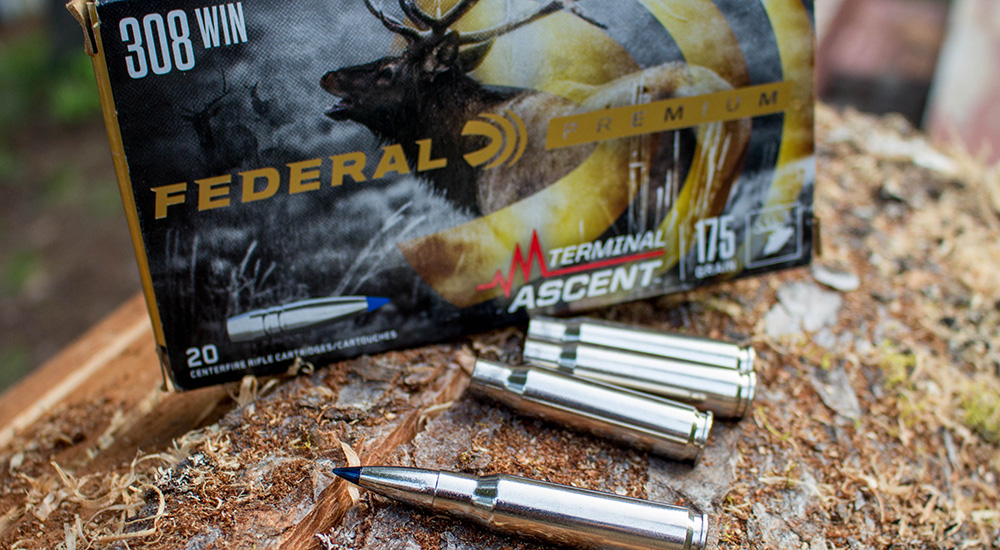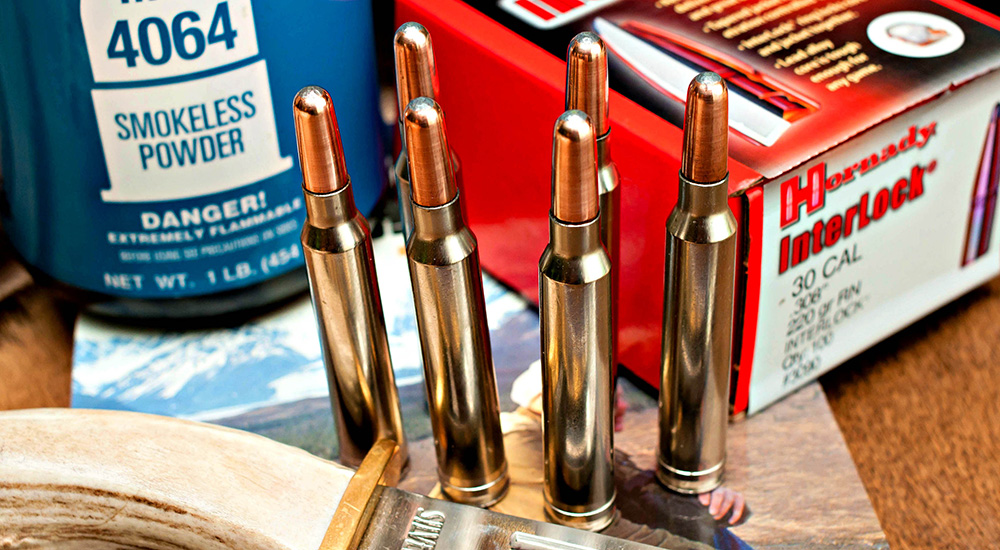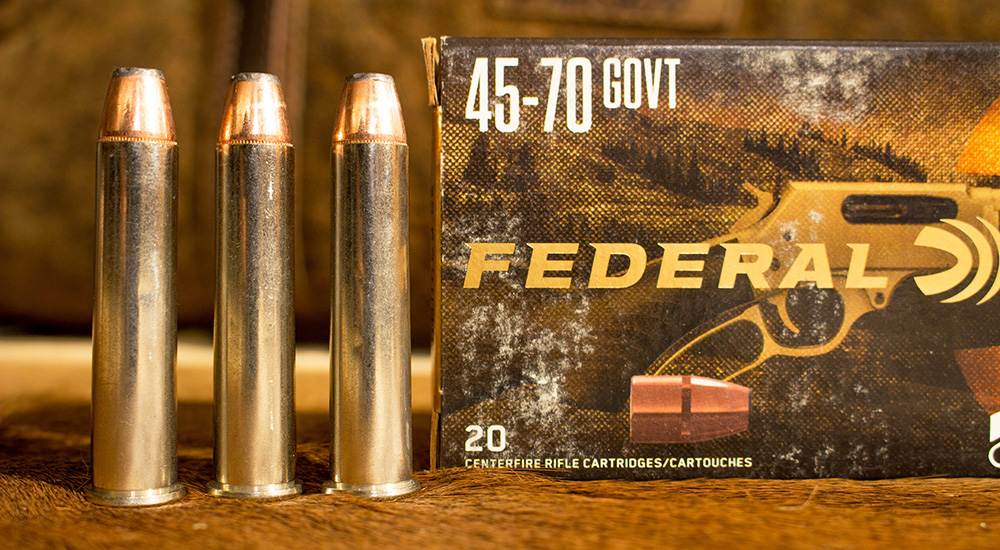Idaho’s snowfall had come late in the season, and stayed late, so that the bears were a bit tardy coming out of hibernation. To further complicate matters, temperatures were due to rise into the mid 80s, making for a potentially difficult hunt. In the particular area we were hunting, color-phase black bears were more prevalent than ‘black’ black bears, and as I hadn’t shot a color-phase bear before, I wasn’t about to become picky.
The hunt was actually rather uneventful, and I was happy about that. An hour into my first afternoon sit over bait, a boar whose coat faded from dark chocolate on his muzzle and paws to near blonde on his back made his silent way to the bait barrel, just thirty-some yards from where I was lurking in the bushes. I brought the Savage Impulse up, settled the crosshair on the bear’s shoulder, and sent a 175-grain Federal Terminal Ascent through the vitals, quickly ending my hunt. Once again, the .308 Winchester sealed the deal for me on a black bear.

Black bears are one of our most popular game animals, with 36 states having a season of some sort, as well as the majority of Canadian provinces. Bears are hunted in a number of different manners, including baiting, spot and stalk, ambush and running with hounds. The bears I have taken have been over bait, ambush (in the same manner as many deer hunts are conducted in the Northeast) or spot and stalk. Generally speaking, the ranges at which most black bears are shot range from ‘home-to-first,’ or around 30 yards for many bait sites, to a couple of hundred of yards or maybe a bit more in those open areas of the West where a bear can be glassed at longer distances.
Add in the fact that not all black bears are created equal—Maine and Idaho bears are generally smaller bodied than other areas—and body size can fluctuate heavily, and you may opt to choose a cartridge capable of handling the biggest bear in the area. For example, in the Catskill Mountains, the average bear probably tips the scales at not much over 150 pounds, though we’ve seen more than one break the 600 pound mark, and those two bears are radically different animals. So, how does one pick a black-bear specific cartridge?

I like to start with the bullet, and feel that bears warrant a premium bullet unless you go heavy-for-caliber. Penetration is key, and I prefer to break shoulder bones in addition to destroying vital tissue. I like strong bullets like the Swift A-Frame, Federal Trophy Bonded Tip and Terminal Ascent, Barnes TSX and Woodleigh Weldcore, especially of you like to use bullets in the middle of the weight spectrum. If you opt for heavier bullets, the cup-and-core ELD-X from Hornady, or Sierra’s GameKing will work just fine. The deal is this: bears can soak up lead, and their fur and fat (especially in the fall) can cause entry wounds to plug up quickly. For that reason I really like poking two holes in a bear, as the exit wounds tend to be larger, and the heavier the blood trail the happier I am.
Regarding cartridges, I feel the 7mm and .30-caliber cartridges are the most common for a reason: they are incredibly versatile, and will handle any black bear that God ever made. Among these, some of my favorites are the .308 Winchester, .30-06 Springfield, .300 H&H Magnum and .300 Winchester Magnum, and the 7mm-08 Remington, .280 Ackley Improved and 7mm PRC. I’d also include the 6.8 Western as it runs the 165- and 175-grain .277-inch-diameter bullets, and I love the sectional density of those choices. For those who like the lighter cartridges, I’d say that as an absolute minimum the .25-06 Remington and .257 Weatherby, with premium 120-grain bullets is as low as I’d go. The 6.5mms are great choices when equipped with the proper bullet—yes even the Creedmoor can be a good bear cartridge—as they have a decent sectional density, especially the older cartridges like the 6.5x55SE with the 156-grain slugs.

Now, the old phrase “loaded for bear” isn’t unfounded, and if logic seems to be pushing you to larger cartridges, I’m with you. A black bear can be killed easily, but if hit wrong, has the potential to be a formidable foe. I like the medium velocity cartridges when of bigger bore diameters, like the .338 Federal, .338-06 A-Square (and its older relation, my personal favorite, the .318 Westley Richards) and 35 Whelen. I’ve hunted—though not killed—bears with the .375 Holland & Holland, and used my .404 Jeffery in Alaska when I held tags for both black and brown bears. I’m not sure you’ll see the huge difference when using a big bore on black bears that you will when dealing with brown bears, but there’s also nothing wrong with hedging your bets. The blackie I took in Alaska wasn’t overly impressed with the 450-grain Woodleigh from the Bansner & Co. .404 Jeffery, though he expired quickly.
The lever guns are still popular choices, and make a great rifle for bait hunting. Whether chambered in .30-30 Winchester, .32 Winchester Special, .348 Winchester, .35 Remington or .45-70 Government, at traditional blind-to-bait distances, they’ll get the job done. Again, I’d personally opt for bullets on the heavier side, as penetration is the game here. Looking at handguns, there are great loads for the .357 Magnum, .41 Magnum, .44 Magnum and .45 Colt, and should you like recoil, the .454 Casull and .480 Ruger. I would opt for a good jacketed hollowpoint with a thick jacket, or perhaps a hard-cast lead bullet of sufficient weight.

Odds are, unless you’ve chosen a .22-caliber centerfire or one of the 6mms for deer hunting, your deer rifle can pull double duty as a black bear rifle, so long as you opt for the proper projectile. The .270 Winchester, 7mm Remington Magnum and If I were to set up a rifle specifically for black bears, it’d probably be a .308 Winchester or .30-06 Springfield, in a rifle of moderate barrel length—long enough to reach out to 250 yards confidently, but short enough to be handy in a blind or stand. I’d want a good bullet, like the Nosler Partition or Federal Trophy Bonded Tip, to handle both close shots and those on the longer side, and a scope in the 2-10x range, bright enough to handle those last light bait shots. I won’t say that a magnum cartridge is needed, but I won’t say it’s unnecessary either. I’ve taken bears with the .300 Winchester Magnum (with 220-grain Hornady InterLocks) and the 7mm PRC (with the 175-grain ELD-X) and I’ll have you know that neither were “too dead”. I can always load a magnum cartridge down, but it’s hard to load a 308 Winchester to 300 Winchester Magnum specs; if you like a magnum cartridge, just pair it with the proper bullet.
No matter the hunting style, the perfect black bear cartridge is most likely already in your gun safe, just be sensible about your choice and respect the potential of the animal; using a rifle/cartridge combination you are already familiar with will probably aloe proper shot placement.











































